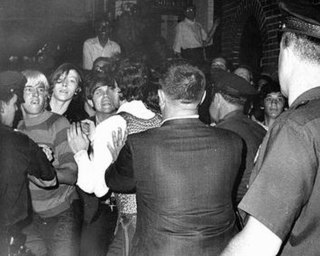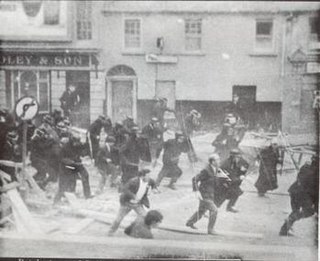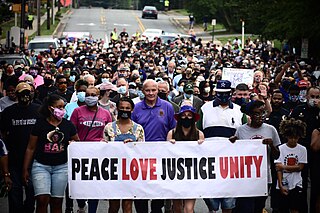Related Research Articles

The Stonewall riots were a series of spontaneous riots and demonstrations against a police raid that took place in the early morning hours of June 28, 1969, at the Stonewall Inn, in the Greenwich Village neighborhood of New York City. Although the demonstrations were not the first time American homosexuals fought back against government-sponsored persecution of sexual minorities, the Stonewall riots marked a new beginning for the gay rights movement in the United States and around the world.

The White Night riots were a series of violent events sparked by an announcement of a lenient sentencing of Dan White for the assassinations of George Moscone, the mayor of San Francisco, and of Harvey Milk, a member of the city's Board of Supervisors who was one of the first openly gay elected officials in the United States. The events took place on the night of May 21, 1979, in San Francisco. Earlier that day White had been convicted of voluntary manslaughter, the lightest possible conviction for his actions. The lesser conviction outraged the city's gay community, setting off the most violent reaction by gay Americans since the 1969 Stonewall riots in New York City.

The 1992 Los Angeles riots were a series of riots and civil disturbances that occurred in Los Angeles County, California, United States, during April and May 1992. Unrest began in South Central Los Angeles on April 29, after a jury acquitted four officers of the Los Angeles Police Department (LAPD) charged with using excessive force in the arrest and beating of Rodney King. The incident had been videotaped by George Holliday, who was a bystander to the incident, and was heavily broadcast in various news and media outlets.

The Hough riots were riots in the predominantly African-American community of Hough in Cleveland, Ohio, United States which took place from July 18 to 23, 1966. During the riots, four African Americans were killed and 50 people were injured. There were 275 arrests and numerous incidents of arson and firebombings. City officials at first blamed black nationalist and communist organizations for the riots, but historians generally dismiss these claims today, arguing that the cause of the Hough Riots were primarily poverty and racism. The riots caused rapid population loss and economic decline in the area, which lasted at least five decades after the riots.

The Glenville shootout was a gun battle that occurred on the night of July 23–24, 1968, in the Glenville section of Cleveland, Ohio, in the United States. Gunfire was exchanged for roughly four hours between the Cleveland Police Department and the Black Nationalists of New Libya, a Black Power group. The battle led to the death of three policemen, three suspects, and a bystander. At least 15 others were wounded.

The 1966 Hong Kong riots, also known as the 1966 Star Ferry riots, were a series of disturbances that took place over four nights on the streets of Kowloon, Hong Kong in the spring of 1966. The riots started as peaceful demonstrations against the British colonial government's decision to increase the fare of Star Ferry foot-passenger harbour crossing by 25 percent.

During 12–16 August 1969, there was an outbreak of political and sectarian violence throughout Northern Ireland, which is often seen as the beginning of the thirty-year conflict known as the Troubles. There had been sporadic violence throughout the year arising out of the Northern Ireland civil rights campaign, which demanded an end to discrimination against Catholics and Irish nationalists. Civil rights marches had been attacked by Protestant loyalists, and protesters often clashed with the Royal Ulster Constabulary (RUC), the overwhelmingly Protestant police force.

The Harlem riot of 1964 was a race riot that occurred between July 16 and 22, 1964 in the New York City neighborhoods of Harlem and Bedford-Stuyvesant, United States. It began after James Powell, a 15-year-old African American, was shot and killed by police Lieutenant Thomas Gilligan in front of Powell's friends and about a dozen other witnesses. Hundreds of students from Powell's school protested the killing. The shooting set off six consecutive nights of rioting. By some accounts, 4,000 people participated in the riots. People attacked the New York City Police Department (NYPD), destroyed property, and looted stores. Several rioters were severely beaten by NYPD officers. The riots and unrest left one dead, 118 injured, and 465 arrested.

A police van is a type of vehicle operated by police forces. Police vans are usually employed for the transport of prisoners inside a specially adapted cell in the vehicle, or for the rapid transport of a number of officers to an incident.

In early August 2011, England was struck by riots, the worst in the country in decades. The timeline of the events of the riots spanned from 6–10 August.
The 1970 Memorial Park riot was a civil disturbance by alienated white youths that began in Royal Oak, Michigan, on August 24, 1970, and spread to Birmingham, Michigan, both primarily white middle class suburbs of Detroit. The initial conflict resulted from the closure by police of Memorial Park in Royal Oak. Authorities said that the park was being used as a marketplace for the sale of illegal drugs. The riot lasted for three days, and led to the formation of several youth controlled social service organizations.

The King assassination riots, also known as the Holy Week Uprising, were a wave of civil disturbance which swept across the United States following the assassination of Martin Luther King Jr. on April 4, 1968. Some of the biggest riots took place in Washington, D.C., Baltimore, Chicago, and Kansas City.

On April 12, 2015, Baltimore Police Department officers arrested Freddie Gray, a 25-year-old African American resident of Baltimore, Maryland. Gray's neck and spine were injured while he was in a police vehicle and he went into a coma. On April 18, there were protests in front of the Western district police station. Gray died on April 19.

The Baltimore railroad strike of 1877 involved several days of work stoppage and violence in Baltimore, Maryland, in 1877. It formed a part of the Great Railroad Strike of 1877, during which widespread civil unrest spread nationwide following the global depression and economic downturns of the mid-1870s. Strikes broke out along the Baltimore and Ohio Railroad (B&O) on July 16, the same day that 10% wage reductions were scheduled.
The 2007 Terengganu riot was an incident on 8 September 2007 in Terengganu, Malaysia where a peaceful rally became violent after intervention by the Malaysian police. The police fired water cannons, tear gas, and live ammunition at the rally participants, and two protestors were injured from the police's gunshots. Following the riot, the Human Rights Commission of Malaysia announced that they would open inquiries probing into the events of that night.

This is a list of George Floyd protests in North Carolina, United States.

On the night of 11 August and the early hours of 12 August 2020, violent clashes took place around the residence of a legislator and the police stations of KG Halli and DJ Halli of the Indian city of Bangalore, Karnataka. A group of Muslims, angered by a Facebook post on Muhammad allegedly shared by Akhanda Srinivas Murthy's nephew, a state legislator of the Indian National Congress, arrived at his house in protest, which later turned violent.

False rumors of a police shooting resulted in rioting, arson, and looting in the U.S. city of Minneapolis from August 26–28, 2020. The events began as a reaction to the suicide of Eddie Sole Jr., a 38-year old black man who was being pursued by Minneapolis police officers for his alleged involvement in a homicide. At approximately 2 p.m. on August 26, Sole died after he shot himself in the head as officers approached to arrest him. False rumors quickly spread on social media that Minneapolis police officers had fatally shot Sole. To quell unrest, Minneapolis police released closed-circuit television surveillance footage that captured Sole's suicide, which was later confirmed by a Hennepin County Medical Examiner's autopsy report.
The 1967 Tampa riots were a series of race riots during June 1967 in Tampa, Florida, as one of 159 such riots in the United States that summer.
References
- 1 2 3 4 5 "Statement of heritage impact : Star Hotel and apartments 569-573 Hunter Street Newcastle West NSW 2300 : Lot 1 DP 739153" (PDF). Hunter Living Histories. Retrieved 8 September 2020.
- 1 2 "The night the Star exploded". The Sydney Morning Herald. 17 September 2004. Retrieved 6 June 2020.
- 1 2 3 4 5 6 "Star Hotel Riot Full Documentary (Official)". YouTube - Stories of Our Town. Archived from the original on 21 December 2021. Retrieved 8 September 2020.
- ↑ Anthony Scully and Ben Millington (20 September 2019). "Lost tapes from Newcastle's Star Hotel riot resurface in new documentary series". ABC News.
- 1 2 3 4 5 "Star wake riot rocks city". The Newcastle Sun. 20 September 1979.
- 1 2 3 4 "Many hurt, cars gutted in riot". Newcastle Morning Herald and Miners' Advocate. 20 September 1979.
- 1 2 3 Ray, Greg (13 September 2019). "Star Hotel riot: the infamous night of music and mayhem in Newcastle". Newcastle Herald. Retrieved 8 September 2020.
- 1 2 CHAD WATSON (9 January 2015). "The real story behind the Star Hotel riot". Newcastle Herald. Retrieved 8 September 2020.